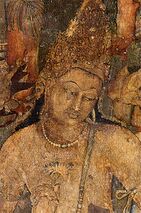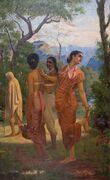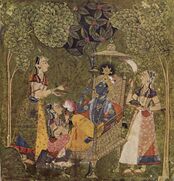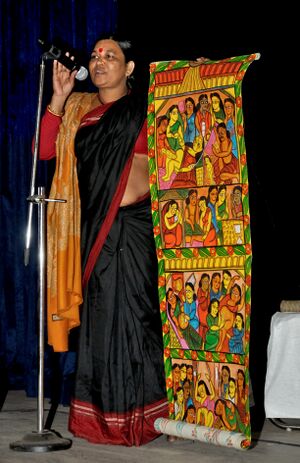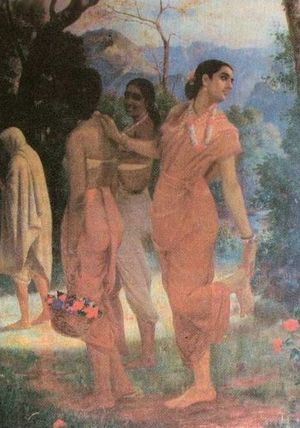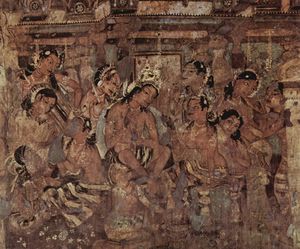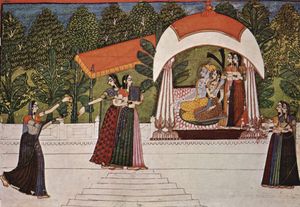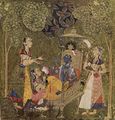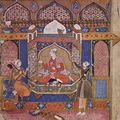التصوير الهندي
| صيغ الفن في الهند |
|---|
 |
التصوير الهندي هو أحد صيغ الفن الهندي. The earliest Indian paintings were the rock paintings of prehistoric times, such as the petroglyphs found in places like Bhimbetka rock shelters. Some of the Stone Age rock paintings found among the Bhimbetka rock shelters are approximately 10,000 years old.
India's ancient Hindu and Buddhist literature has many mentions of palaces and other buildings decorated with paintings (chitra),[1] but the paintings of the Ajanta Caves are the most significant of the few ones which survive. Smaller scale painting in manuscripts was probably also practised in this period, though the earliest survivals are from the medieval period.[2] A new style emerged in the Mughal era as a fusion of the Persian miniature with older Indian traditions, and from the 17th century its style was diffused across Indian princely courts of all religions, each developing a local style. Company paintings were made for British clients under the British raj, which from the 19th century also introduced art schools along Western lines. This led to modern Indian painting, which is increasingly returning to its Indian roots.
Indian paintings can be broadly classified as murals, miniatures and paintings on cloth. Murals are large works executed on the walls of solid structures, as in the Ajanta Caves and the Kailashnath temple. Miniature paintings are executed on a very small scale for books or albums on perishable material such as paper and cloth. Traces of murals, in fresco-like techniques, survive in a number of sites with Indian rock-cut architecture, going back at least 2,000 years, but the 1st and 5th-century remains at the Ajanta Caves are much the most significant.[3]
Paintings on cloth were often produced in a more popular context, often as folk art, used for example by travelling reciters of epic poetry, such as the Bhopas of Rajasthan and Chitrakathi elsewhere, and bought as souvenirs of pilgrimages. Very few survivals are older than about 200 years, but it is clear the traditions are much older. Some regional traditions are still producing works.[4]
Overview of the main genres
It seems clear that miniature painting, often illustrating manuscripts, has a very long history,[5] but Jain miniatures from about the 12th century, mostly from West India, and slightly earlier Buddhist ones from the Pala Empire in the east are the oldest to survive.[6] Similar Hindu illustrations survive from about the 15th century in the west, and 16th century in East India,[7] by which time the Mughal miniature under Akbar was also sometimes illustrating translations into Persian of the Hindu epics and other subjects.[8]
The great period of Mughal court painting begins with the return of Humayun from exile in Persia 1555, bringing Persian artists with him. It ends during the reign of Aurangzeb who rather disapproved of painting for religious reasons, and disbanded the large imperial workshop, by perhaps 1670. The artists dispersed to smaller princely courts, both Muslim and Hindu, and the "post-Mughal" style developed in many local variants.[9] These included different Rajasthani schools of painting like the Bundi, Kishangarh, Jaipur, Marwar and Mewar. The Ragamala paintings also belong to this school, as does the later Company painting produced for British clients from the mid-18th century.
Modern Indian art has seen the rise of the Bengal School of art in 1930s followed by many forms of experimentations in European and Indian styles. In the aftermath of India's independence, many new genres of art developed by important artists like Jamini Roy, M. F. Husain, Francis Newton Souza, and Vasudeo S. Gaitonde. With the progress of the economy the forms and styles of art also underwent many changes. In the 1990s, Indian economy was liberalised and integrated to the world economy leading to the free flow of cultural information within and without. Artists include Subodh Gupta, Atul Dodiya, Devajyoti Ray, Bose Krishnamachari and Jitish Kallat whose works went for auction in international markets. Bharti Dayal has chosen to handle the traditional Mithila painting in most contemporary way and created her own style through the exercises of her own imagination, they appear fresh and unusual.
سادانگا التصوير الهندي
السادانگا أو شادَنگا ، هو لفظ أو تشريع هندي كتبه ياشودارا في مجموعة كتبه المسماة ڤيشنو دارموتـّارا پورانا. والشادنگا تختص بفن التصوير ، ويعني "الأطراف الستة للتصوير الهندي" وهي شبيهة بما وضعه الصينيّ، هشيه هو Hsieh Lo، بعد ذلك ، وربما كان الصينيّ في ذلك مقلداً ، وهو ستة قوانين لإتقان فن التصوير:
1- معرفة ظواهر الأشياء.
2- صحة الإدراك الحسي والقياس البنّاء.
3- فعل المشاعل في القوالب الفنية.
4- إدخال عنصر الرشاقة ، أو التمثيل الفني.
5- مشابهة الطبيعة.
6-استخدام الفرجون والألوان استخداماً فنيا.
Murals
رسم المنمنمات
التصوير المغولي
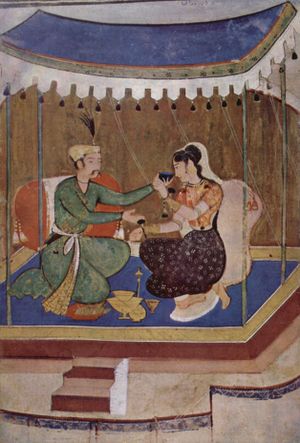
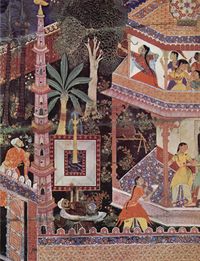
Rajput painting
Mysore painting
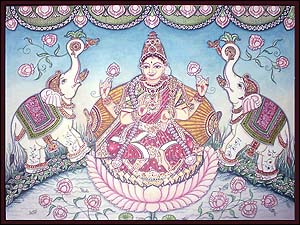
المصادر
ديورانت, ول; ديورانت, أرييل. قصة الحضارة. ترجمة بقيادة زكي نجيب محمود.
Gallery
Some notable Indian paintings
- Hemen Majumdar's "Lady with the Lamp"
- Rabindranath Tagore's "Self portrait"
- Abanindranath Tagore's Bharat Mata
- Raja Ravi Varma's Shakuntala
- Ramkinkar Baij's "Jakkha 0 Jakkhi"
- Bikash Bhattacharya's "Doll-series"
- Geeta Vadhera's Jogia "Dhoop series"[10]
- Jahar Dasgupta's "Confrontation"[11]
- MF Hussain's "Horses-series"
- Jamini Roy's "Jesus"
- John Wilkins's "Gossip",
- Rakesh Vijay "Persian and Mogul styles"
- Narayanan Ramachandran's "Return from Market"
- Jainul Abedin's "Series on Bengal Famine"
- Sunil Das's "Bull Series"
- Devajyoti Ray's "In Despair"
- Tyeb Mehta's "Mahisasur"
- B. G. Sharma's Krishna miniatures[12][13]
انظر أيضاً
Notes
- ^ Wall painting
- ^ خطأ استشهاد: وسم
<ref>غير صحيح؛ لا نص تم توفيره للمراجع المسماةBlurton, 193 - ^ Harle, 355–361; Wall painting
- ^ Blurton, 201–203, 209–210, 221–222
- ^ Craven, 219; Harle, 361
- ^ Miniature painting; Harle, 361–364
- ^ Blurton, 200–201, 209–210
- ^ Blurton, 193; Harle, 373
- ^ Harle, 372–382
- ^ [1]
- ^ [2]
- ^ [3]
- ^ [4]
للاستزادة
- Indian Painting, by Percy Brown. Published by Y. M. C. A. publishing house, 1960.
- Indian Painting, by Philip S. Rawson. Published by P.Tisné, 1961.
- Indian Painting: The Scene, Themes, and Legends, by Mohindar Singh Randhawa, John Kenneth Galbraith. Published by Houghton Mifflin, 1968.
- Indian Painting, by Douglas E. Barrett, Basil Gray. Published by Skira, 1978. ISBN 0847801608.
- A History of Indian Painting: The Modern Period by Krishna Chaitanya. Published by Abhinav Publications, 1994. ISBN 8170173108.
وصلات خارجية
| Paintings from India
]].- Studio3 Art Gallery - Indian Contemporary Art Website
- The Arts Trust- Biggest Indian art website
- Paintings of India
- Example of Traditional Indian Paintings and Indian Art Prints
- Online exhibits

